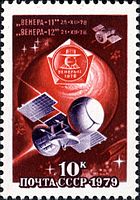Venera 11

Seal of Venera 11
|
|
| Operator | Soviet Academy of Sciences |
|---|---|
| COSPAR ID | 1978-084A |
| SATCAT № | 11020 |
| Spacecraft properties | |
| Spacecraft | 4V-1 |
| Bus | 4MV |
| Launch mass | 4,940 kg (10,890 lb) |
| Landing mass | 760 kg (1,680 lb) |
| Start of mission | |
| Launch date | September 9, 1978, 03:25:39 UTC |
| Rocket | Proton with upper and escape stages |
| Launch site | Baikonur 81/23 |
| Orbital parameters | |
| Reference system | Geocentric |
| Regime | Low Earth |
| Semi-major axis | 6,569 kilometers (4,082 mi) |
| Perigee | 177 kilometres (110 mi) |
| Apogee | 205 kilometres (127 mi) |
| Inclination | 51.5° |
| Flyby of Venus | |
| Spacecraft component | Venera 11 flight platform |
| Closest approach | 25 December 1978 |
| Distance | 34,000 kilometers (21,000 mi) |
| Venus lander | |
| Spacecraft component | Venera 11 descent craft |
| Landing date | 25 December 1978, 03:24 |
| Landing site | 14°S 299°E / 14°S 299°E |
The Venera 11 (Russian: Венера-11 meaning Venus 11) was a Soviet unmanned space mission part of the Venera program to explore the planet Venus. Venera 11 was launched on 9 September 1978 at 3:25:39 UTC.
Separating from its flight platform on December 23, 1978 the lander entered the Venus atmosphere two days later on December 25 at 11.2 km/s. During the descent, it employed aerodynamic braking followed by parachute braking and ending with atmospheric braking. It made a soft landing on the surface at 06:24 Moscow time (03:24 UT) on 25 December after a descent time of approximately 1 hour. The touchdown speed was 7 to 8 m/s. Information was transmitted to the flight platform for retransmittal to earth until it moved out of range 95 minutes after touchdown. Landing coordinates are 14°S 299°E / 14°S 299°E.
After ejection of the lander probe, the flight platform continued on past Venus in a heliocentric orbit. Near encounter with Venus occurred on December 25, 1978, at approximately 34,000 km altitude. The flight platform acted as a data relay for the descent craft for 95 minutes until it flew out of range and returned its own measurements on interplanetary space.
Venera 11 flight platform carried solar wind detectors, ionosphere electron instruments and two gamma ray burst detectors – the Soviet-built KONUS and the French-built SIGNE 2. The SIGNE 2 detectors were simultaneously flown on Venera 12 and Prognoz 7 to allow triangulation of gamma ray sources. Before and after Venus flyby, Venera 11 and Venera 12 yielded detailed time-profiles for 143 gamma-ray bursts, resulting in the first ever catalog of such events. The last gamma-ray burst reported by Venera 11 occurred on January 27, 1980
...
Wikipedia
